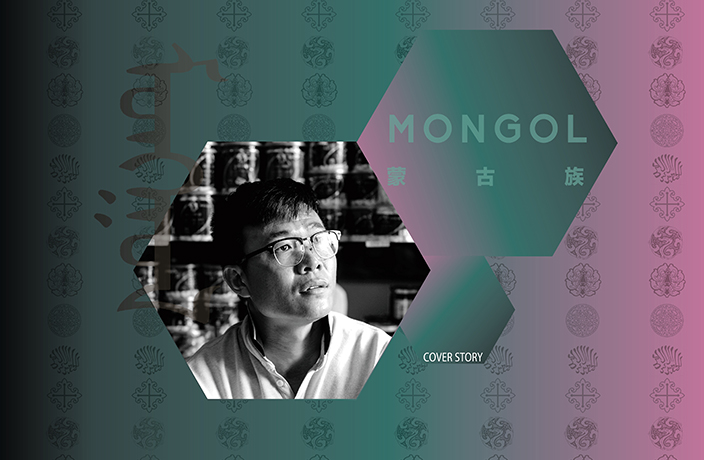For this month’s cover story we met with individuals from Beijing’s three largest non-Han groups: Manchu, Hui and Mongol, which between them make up more than four-fifths of Beijing’s ethnic minority population. In Part I of this three-part series, we took an in-depth look at the Mongol community.
In the absence of the real thing, Mongols have taken to projecting HD video footage of their beloved grassland onto the walls of Beijing.
We’re at Ba Yin Hao Ri Wa, a palatial Mongolian restaurant, and this is the second such video projection we’ve seen this week. Ultra-saturated greens and blues dance along the 10-foot-tall screen. Horses gallop across empty fields. Wind ripples through stalks of wheat. Grassy hills stretch into the distance.

The manager of Ba Yin Hao Ri Wa sits in his restaurant
It’s Mongolian grassland porn in the middle of Beijing’s Fengtai district. Movie projector or not, every Mongolian restaurant we visit has some way of showing off Northern landscapes. There are murals, large-scale photographs and tapestries. And every Mongol we speak to in Beijing brings them up, too.
“The grassland is extremely important in shaping Mongols’ lifestyles and personalities,” says Bao Zexuan, a doctor and ethnic Mongol who grew up on the grassland of China’s Inner Mongolia Autonomous Region. “Its vastness makes Mongolians more straightforward and tolerant.”
Bao was raised in a Mongolian-speaking home, but later moved to the provincial capital of Hohhot for school. And while his Mandarin is flawless today, he came to Beijing for university with a thick accent.

Doctor Bao Zexuan sits in his friend's Mongol food shop
Mongols are the third-most-populous minority group in Beijing, and are recognized by the code ‘MG’ on their citizen IDs. In total, there are over 5.9 million on the Chinese Mainland – roughly twice the number living in Mongolia (the country) proper.
Over two-thirds of Mongols in China are based in Inner Mongolia, where they make up 17 percent of the population. That percentage drops to 8 percent in Hohhot. Mongols, after all, are traditionally countryside dwellers.
“I still feel considerably intimate with the grassland,” says Bao. “Whenever I returned to my hometown after being in the city for high school, I’d cry.”
For centuries, Mongols have been nomads, the windswept grassland their home. Many have been herdsmen, keeping charge of cattle or sheep. The yurts (large, circular white tents) that we associate with the group are easily compactable – designed for the traveling lifestyles their inhabitants live.

A woman in traditional dress plays as part of a Mongol musical trio
Bao speaks to us from a small stool in his friend’s Mongolian food shop inside Chongwenmen’s massive Inner Mongolia Hotel. A traditional Mongolian band plays in the lobby. Here in the shop, food surrounds us. There are milk candies, wheat crackers and strong baijius. At the grocery’s center is a series of industrial-sized refrigerators containing Mongolian beef and lamb straight from the grassland – the store’s most popular items.
Mongolian food is typically broken down into three categories. There’s “white food,” which consists of dairy products, or anything including dairy; “red food,” which stands for meat; and wine. Mongolians even combine the first and the latter with naijiu (‘milk wine’).

A bronze pot holds a mixture of millet and milk
“When my parents were young, they still raised cattle on the grassland,” says De Bulang, a Hohhot-born Mongol also based in Beijing. “Sheep in Hohhot eat grass, so they are cleaner and more tender.”
One could call Mongolian cuisine the original organic; free-range beef before it was cool. Indeed, Mongol eating practices are both clean and eco-friendly. De points to a Mongol expression as evidence: “If you do not scatter the stones, the devil will come out.”
“Scatter the stones” essentially means “clean up after yourself” – Mongols traditionally believed that if they failed to do so when moving from one settlement to the next (read: if they polluted), they’d have bad luck. This eco-consciousness finds its way into Mongolian cuisine.

“Traditionally, before they killed the cattle, Mongolians would check the calendar to see if it was a suitable date for killing,” says the manager of the aforementioned restaurant, sounding an awful lot like an organic farmer in 2016. “Even today, the sheep are only killed in certain seasons when they do not have a certain smell.”
In a food industry that’s increasingly mechanical and processed – the slow, careful way Mongols raise their cattle is a precious rarity. The restaurant manager is “furious” about how food is mass-produced in today’s China, calling large-scale producers “immoral.” He does not hold his tongue.
“All ethnic groups have their food culture, but food is particularly important for Mongols,” he says.
Both De and Bao agree, saying that in the absence of grassland in Beijing, they use food to connect with their culture.
“I mainly eat red meat,” says Bao, who tries to cook traditional Mongolian food whenever he’s not busy working. (No amount of work, though, keeps him from drinking Mongolian milk tea, he adds.) De also has a "red food"-heavy diet, mostly from his frequent visits to Beijing Mongolian restaurants. He raves to us about his chef friend’s yangrou shumai (lamb dumplings).
These shumai are remnants of Mongol culture in a city of concrete hutongs far, far away from the grassland. And yet even the word 'hutong' is derived from Mongolian, having first appeared during the Mongol-ruled Yuan dynasty. Beijing is, as that fact ought to demonstrate, a city profoundly marked by Mongol influence.

A visitor to Chongwenmen's Inner Mongolia Hotel looks at Mongolian script
It’s been a while since the Mongols’ 13th century invasion of Zhongyuan (literally ‘central plain’ – areas south of the Great Wall) but Kublai Khan’s presence lingers. Khan ordered the construction of the oft-visited Kunming Lake at the Summer Palace, and his empire also connected the Grand Canal to the Forbidden City.
Throughout the Yuan Dynasty, the Khans and their successors took on the customs of Beijing. Many ditched Mongolian in favor of Mandarin, and dropped their nomadic ways altogether. Maybe it’s fitting, then, that Mongols are doing the same thing today.
Most Mongols in Beijing, while fiercely proud of Inner Mongolia’s grassland, consider leaving them behind as a necessary sacrifice for the greater economic opportunities of the city. The ones we speak to, at least, say they wouldn’t trade their current lives for the old days, though they’re all university-educated white-collar workers.

“I go to the grassland every year,” says the restaurant manager. “But I know that I can’t stay there forever.”
The HD scenes of grazing cattle behind him will have to suffice.
Additional reporting by Emma Huang
Images by Holly Li
Read Part I – In the Minority: Huis Facing Mecca from Beijing & Part II – In the Minority: Manchus, The Last Emperors






















0 User Comments